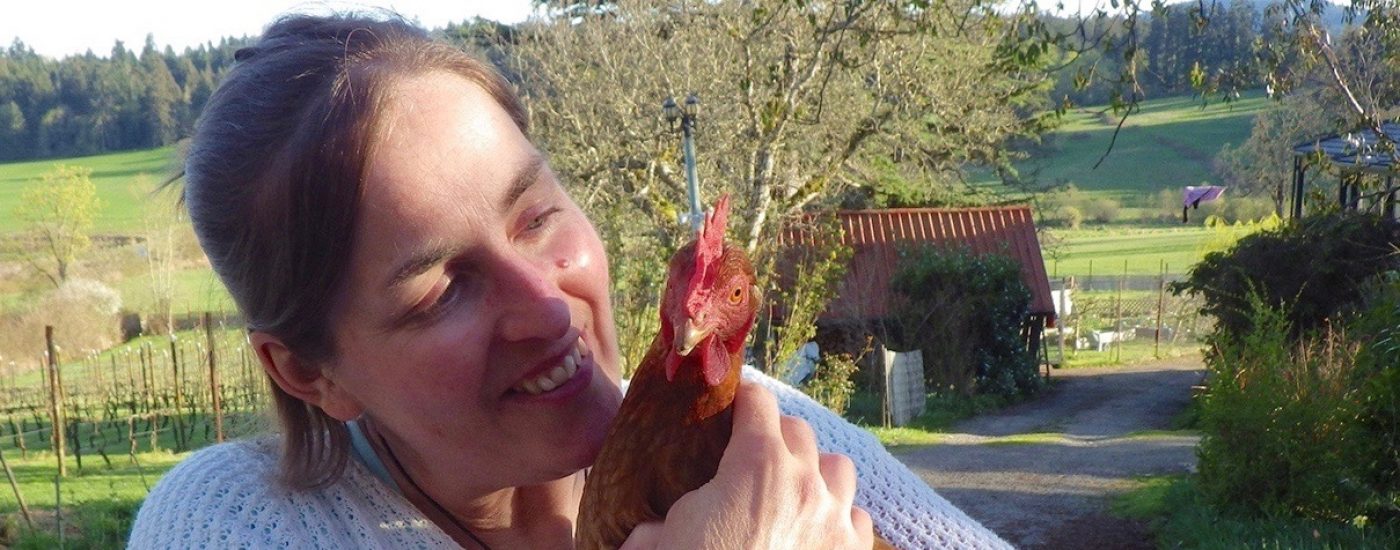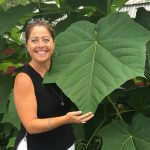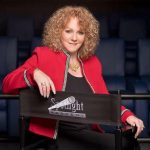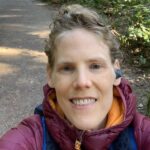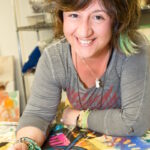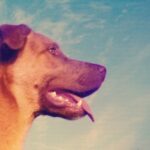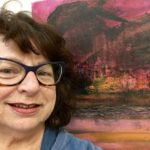Today we raise our fists high and put our hands together in celebration of our Feature Girl Warrior, award winning artist, Lori Waters who combines her love of science and art to create medical and scientific educational animations and illustrations. Lori earned her BFA in Visual Arts and Art History at the UVic; her MFA in Ghana, West Africa; studied sciences at BC Open University; and earned her Masters of Science in Biomedical Communications at the University of Toronto Faculty of Medicine. She has won numerous awards for her work, including the Helen Pitt Award for Fine Arts, a Commonwealth Scholarship, a Faculty of Medicine Entrance Scholarship, Massey College bursaries, and the Canadian Federation of University Women (CFUW) Beverley Jackson National Fellowship. Lori was a resident Junior Fellow of Massey College, and in 2006 was chosen as one of four North American Vesalian Scholars, along with colleagues from Johns Hopkins Medical School. Her MSc project on HIV infection was funded through a Canadian Institutes of Health Research (CIHR) Health Research Communications award, and upon her graduation in 2007, she was awarded a Government of Canada “Canadian Cultural Personality” award, for an volunteer and speaking trip to assist at HIV organizations in Kenya. More recently, (and in addition to medical visualization work), Lori has been contracted to do increasing amounts of scientific visualization, with much of the subject matter focused on oceanography and climate change. Projects have included climate change exhibits for the Emperor of Japan, book illustrations for a Marine Environment texts, and a bathymetry animation of Active Pass, among others. Lori enjoys the challenges of being a biomedical illustrator / animator, and endeavours to spend her spare time enjoying nature, singing, playing music, painting and drawing, gardening, knitting and crocheting, and being active in the community!
What makes you a Girl Warrior?
Girl Warriors are willing to stand up for what is right; speak truth to power; and do what needs to be done, regardless of how difficult a challenge may be. Being a Girl Warrior requires vision, strength, stamina, and courage of conviction to make the world a better place. I endeavour to be a Girl Warrior, and to embody these attributes through the choices I make in my personal and professional life.
You are accomplished in so many areas, a true Renaissance woman with both sides of your brain firing on all cylinders! Let’s start with your illustration work, which is breathtakingly beautiful. Tell us a bit about the type of technical illustration work you do and what inspires you.
I’m really fortunate to have gone through rigorous formal training in medical and scientific illustration, and additional courses in botanical, entomological, ornithological, and anthropological illustration. I really enjoy the range of work, because it is endlessly interesting and fascinating. The work itself is intense (as I’m often writing and designing as well as doing illustration), and requires concentration and in-depth research. I am inspired by the engaged intelligent people I get to work with, who are primarily concerned with using their talents to make the world a better place. I also love being able to use my skills, combining research, traditional drawing and painting techniques, and digital technology, to communicate complex concepts in a way that helps people to understand them… and, I like to make beautiful things… it is very satisfying.
You’re a Partner/President of Oceanetic Measurement, which specializes in the design and manufacturing of instrumentation to monitor climate change, among other things. What’s your role there?
Oceanetic is somewhat of a tangential role for me – mostly it allows me to build things, and participate in scientific fieldwork, which I enjoy very much. Science is yet another way to observe the world, and to make interesting connections with living things. I look after Oceanetic’s marketing materials, participate in mechanical assembly and soldering parties, design and build lightweight subsea moorings for arctic cetacean monitoring a couple of times a year, and participate in scientific fieldwork whenever I can.
What do we need to know “for sure” about climate change?
I have been fortunate to visit the arctic a number of times now in the past decade, and anyone who has any doubts regarding climate change needs to travel there to speak with residents, and to witness it for themselves. Climate change is real, and it requires urgent action on all of our parts. If we collectively act, there are several key actions we can take in our own lives that have the potential to create significant change globally: switching to a vegetarian or vegan diet; reducing or eliminating long-haul flights from our lives; and reducing our personal carbon footprints by eliminating or reducing car travel by switching to transit, bikes, or electric cars where possible.
What did you learn from your experience conducting research and writing for Elizabeth May, MP?
It is possible for one person to make a difference when they are intelligent, tenacious, motivated by creating positive change, and willing to listen and work with others.
Why did you spend six months advocating and rallying support for the preservation of Crystal Garden Conservation Centre? Why was that so important to you?
People have made many changes to our planet – some of which are irreversible. Of these, what concerns me greatly is our negative impact on other species. Humans seem to be shortsighted when it comes to the changes we make, and collectively we seem to have trouble acting towards positive change. I find it heartbreaking that man has facilitated the extinction of so many species, and I believe it is our duty to ensure the survival of species other than ourselves. The Crystal Garden Conservation Centre was one of the world’s most successful endangered species breeding facilities, prior to its closure in 2006. My motivation for supporting their conservation efforts sprang from my belief that humans need to work to save other species – especially those that are endangered as a result of human actions. It is the same motivation that caused me to lobby politicians to keep open the Northern Abalone breeding facility at Bamfield, and to lobby for increased protection for Southern Resident Killer Whales. When species are lost, they’re gone forever, and the significance of these losses cannot be downplayed.
You designed and built your own house using as much recycled material as possible. What kinds of things did you use? What was the most unusual thing and where did it end up in your home?
It is astounding the variety of building materials that can be found: structural wood, windows, fixtures, insulation, doors, etc. I used all of these items and more, from an amazing variety of sources, though I think the most interesting recycled materials were the windows that I used in this home. They are wooden sash windows that had originally been part of the M-Hut at the University of Victoria – a wartime structure that was demolished in the 1990’s. When I did my undergraduate visual arts and art history degree at UVic, I spent much of my time at the M-huts, so, by the time I’d installed the windows in my home, I’d already been looking through them for four years. The other used materials I love are my kitchen counters – thick slabs of ponderosa pine that had, for many years, been siding on a trapper’s cabin in the Chilcotin.
If building a house wasn’t remarkable enough, you’ve also rebuilt an aircraft from the wings up. Have you always liked to build things? What’s the best part of taking on projects of such magnitude?
Building, designing, and fixing things is part of my DNA. My mother is an artist and my father – originally a shipwright – was head of construction of exhibits at the BC Provincial Museum (now the Royal BC Museum) when my brother and I were kids. We were taught very early on how to use power tools. I was taught how to use a band-saw at age 6, and I’ve never cut myself on it! It’s difficult for me to put my finger on exactly how to define the sort of personal satisfaction that comes from designing a house and then building it, or fixing an airplane and then flying it. I guess that visualizing a specific project, working towards it, and then having it come to fruition must have a specific type of enjoyable neural transmitter reward!
Besides the magnificent view, what’s it like to fly your plane?
Flying is a wonderful feeling. The multi-faceted challenge of being a pilot – keeping an eye on the engine, navigation, altitude and aircraft attitude – was invigorating. I very much enjoyed the independence of riding my motorcycle to the airport, hopping in the airplane, and quickly and freely travelling to places that otherwise would have taken me significantly longer, enjoying the beauty along the way. However, the downside of this type of travel is a very large carbon footprint, so I couldn’t in good conscience continue to fly simply for pleasure. I’ve since stopped flying for this reason, but still often dream about, and savor my memories of flight. If there are personal electric airplanes in the future, count me in!
What has been your biggest challenge?
I had always thought that I would be a mother. That wasn’t to be. Overcoming the heartbreak of infertility has been a large challenge for me as a woman. It’s something that is painful, and, to be honest, sometimes makes it difficult to fully celebrate the joy of births in others lives. The pain has receded to some degree over time, but having a child is something that I had always anticipated occurring, and it’s a challenge that has been personally very difficult to come to terms with, even over decades. When I speak with young women who are putting off childbearing, I encourage them to consider that childbirth in later years may not be as easy or as ubiquitous as they may think. I feel it’s important to mention this, even though it is a difficult subject, because infertility is on the rise, and it’s important for others in this situation to know that they are not alone, and that it does get better.
What obstacles have you overcome and walls (perhaps literally!) have you broken down?
Two social obstacles come to mind with this question. First, when I lived in West Africa, I was, for the first while, the only white person on campus. It really helped me to better feel and understand racism, and how difficult it can be to talk about race when one is in an extreme minority. The other instance is when I worked as an aircraft mechanic. It was a cold winter day in the hangar, and the “boys” all disappeared, just as I had asked for help, because I was taking off a large, heavy propeller assembly which I needed to get about six feet down to the ground. So, without assistance, it was necessary to build “steps” using plastic milk crates, in order to “walk” the prop assembly down off the bolts, off the plane, and onto the hangar floor. It took not so much strength as ingenuity, but after that time, when I asked for help, it was there. I think just the simple act of (I guess defiantly) doing it myself anyway changed how I was viewed by my male colleagues in the hangar, and I think it really broke down a wall by reducing the sexism in that working environment.
What would you tell your younger Girl Warrior?
I would say that she needs to believe in herself, and to follow her heart. She knows that she is strong, and that she can overcome challenges. Also, I’d ask her to be happy, to do her best to stay healthy, and to try not to worry. Things will work out. Just be positive.
What would you say to the next generation of Girl Warriors looking for inspiration?
I’d ask them to look inside for inspiration. They already have the wisdom, and they have the strength. They are the leaders, and they can do it. They have the power to make the world a better place, and they have the compassion to know what is right and best not only for humanity, but for all the life on earth.
Who is/are your Girl Warrior hero(s)?
My artist girl warrior hero is Emily Carr, because she maintained her vision and worked despite all obstacles. I also greatly admire Elizabeth May, who is incredibly smart, very articulate, and who truly works tirelessly to combat policies or politics that negatively impact our collective ability to respond to climate change. There have been many other Girl Warrior heroes in my life, but these two spring immediately to mind.
What’s next and where do you see yourself in 5 years?
I’m not sure there’s a “what’s next” specifically so much as there is a progression in life. I continue to meet wonderful people, do interesting projects, and strive to learn. I hope that in five years I will speak French better than I do now, will be a better scientific artist, and perhaps will have found a way to strike a better balance between work and home life, in order to create a bit more tranquility on a daily basis. All being well, I may even have built a solar-powered home by then.
You’ve done some acting and even appeared as a Bollywood dancer in the Internet Series “The Yellow Ninja”. If a bioflick were made of your life, what would it be called?
Stardust meat ghost.
(This is from the quote: “You are a ghost, driving a meat-covered skeleton made of stardust, riding a rock, floating through space. Fear nothing.” (Source: unknown) I like this quote very much, as it reminds me that we’re spirits on a human journey – not the other way around… so we must really live.)
What’s it like to hug a chicken?
Chickens are wonderful creatures, with individual personalities. They – probably like corvids – can recognize people, and are adept at doing what they need to do to survive. Hugging a chicken is much like hugging a cat or dog – they’re soft, warm, appear to like the cuddles, and will let you know when they’re done and want down.
To learn more about Lori’s environmental advocacy work, here are just a few of the many articles she has written on the subject:
http://www.huffingtonpost.ca/2012/08/17/lori-waters-enbridge-video-complaint_n_1793400.html

